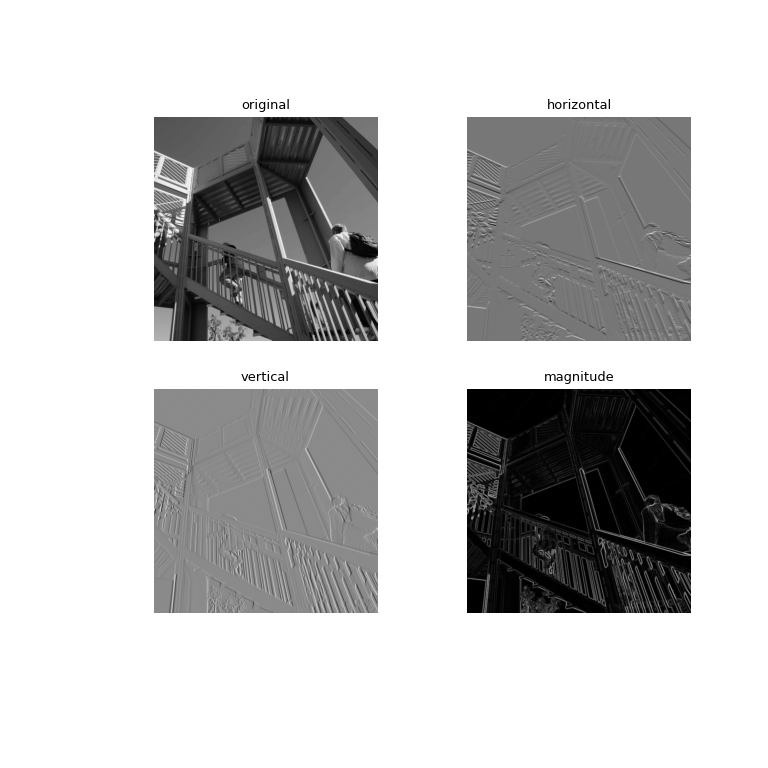scipy.ndimage.
sobel#
- scipy.ndimage.sobel(input, axis=-1, output=None, mode='reflect', cval=0.0)[source]#
计算 Sobel 滤波器。
- 参数:
- inputarray_like
输入数组。
- axisint, optional
计算所沿的 input 轴。默认值为 -1。
- outputarray or dtype, optional
用于放置输出的数组,或返回数组的数据类型。默认情况下,将创建一个与输入数组具有相同数据类型的数组。
- modestr or sequence, optional
mode 参数决定了当滤波器与边界重叠时输入数组如何扩展。通过传入一个长度等于输入数组维度的模式序列,可以为每个轴指定不同的模式。默认值为 'reflect'。有效值及其行为如下:
- ‘reflect’ (d c b a | a b c d | d c b a)
输入通过围绕最后一个像素边缘反射进行扩展。此模式有时也称为半样本对称。
- ‘constant’ (k k k k | a b c d | k k k k)
输入通过使用相同的常数值填充边缘外的所有值进行扩展,该常数值由 cval 参数定义。
- ‘nearest’ (a a a a | a b c d | d d d d)
输入通过复制最后一个像素进行扩展。
- ‘mirror’ (d c b | a b c d | c b a)
输入通过围绕最后一个像素的中心反射进行扩展。此模式有时也称为全样本对称。
- ‘wrap’ (a b c d | a b c d | a b c d)
输入通过环绕到对边进行扩展。
为了与插值函数保持一致,也可以使用以下模式名称:
- ‘grid-constant’
这是 ‘constant’ 的同义词。
- ‘grid-mirror’
这是 ‘reflect’ 的同义词。
- ‘grid-wrap’
这是 ‘wrap’ 的同义词。
- cvalscalar, optional
如果 mode 为 'constant',则用于填充输入超出边缘的值。默认值为 0.0。
- 返回:
- sobelndarray
经过滤波的数组。形状与 input 相同。
备注
此函数计算特定于轴的 Sobel 梯度。可以通过水平变换 (axis=0) 强调水平边缘,通过垂直变换 (axis=1) 强调垂直边缘,对于更高维度以此类推。这些可以组合起来得到梯度幅度。
示例
>>> from scipy import ndimage, datasets >>> import matplotlib.pyplot as plt >>> import numpy as np >>> ascent = datasets.ascent().astype('int32') >>> sobel_h = ndimage.sobel(ascent, 0) # horizontal gradient >>> sobel_v = ndimage.sobel(ascent, 1) # vertical gradient >>> magnitude = np.sqrt(sobel_h**2 + sobel_v**2) >>> magnitude *= 255.0 / np.max(magnitude) # normalization >>> fig, axs = plt.subplots(2, 2, figsize=(8, 8)) >>> plt.gray() # show the filtered result in grayscale >>> axs[0, 0].imshow(ascent) >>> axs[0, 1].imshow(sobel_h) >>> axs[1, 0].imshow(sobel_v) >>> axs[1, 1].imshow(magnitude) >>> titles = ["original", "horizontal", "vertical", "magnitude"] >>> for i, ax in enumerate(axs.ravel()): ... ax.set_title(titles[i]) ... ax.axis("off") >>> plt.show()
